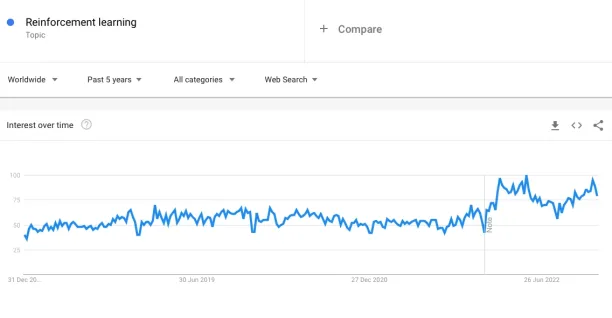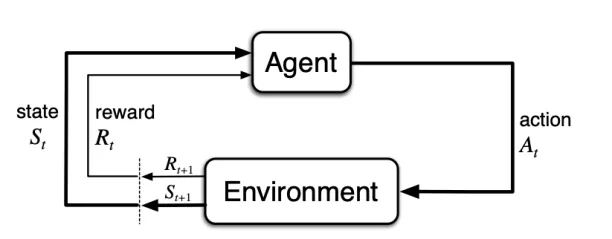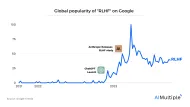Reinforcement Learning: Benefits & Applications in 2024
Machine learning algorithms are used in a wide range of applications, from image recognition to natural language processing (NLP) and predictive analytics. One major challenge in the field of machine learning is designing algorithms that can learn to make complex, long-term decisions in dynamic environments. This is particularly relevant in fields such as robotics and autonomous systems, where the ability to adapt to changing circumstances is crucial.
Reinforcement learning is a type of machine learning algorithm that focuses on training models to make decisions in an environment in order to maximize a reward. This is typically done through trial and error, as the algorithm receives feedback in the form of rewards or punishments for its actions.
In this article, we’ll explore what reinforcement learning is, how it works, its applications, and its challenges.
What is reinforcement learning (RL)?
Reward rules are determined in the reinforcement learning algorithms. The agent of the model tries to reach maximum rewards through its actions. The algorithm starts with trials and learns to make decisions by itself to gain maximum rewards.
Reinforcement learning models can gain experience and feedback (rewards) from their actions which help them to improve their results. This machine learning approach can be best explained with computer games.
What is the level of interest in reinforcement learning?
Reinforcement learning may be a key player in further development and the future of AI. So, the interest in reinforcement learning has been continuing for the last five years. The machine learning domain has been improving reinforcement learning models with new areas such as deep reinforcement learning, associative reinforcement learning, and inverse reinforcement learning. The interest in reinforcement learning is seen below from the chart.

How does it work?
There are five key elements of reinforcement learning models:
- Agent: The algorithm/function in the model that performs the requested task.
- Environments: The world in which the agent carries out its actions. It uses the current states and actions of the agent as input, rewards, and the next states of the agents as output.
- States: It refers to the situation of the agent in an environment. There are current and future/next states.
- Actions: The moves are chosen and performed by the agent to gain rewards.
- Rewards: Reward means desired behaviors that are expected from the agent. Rewards are also called feedback for the agent’s actions in a given state and are described as results, outputs, or prizes in the model.
Different algorithms and approaches are used in the reinforcement learning models. Some of them are listed below.
- Markov Decision Processes (MDPs): It is a framework that is used to model decision-making processes. The decision maker, the states, actions, and rewards are the key elements of MDPs. MDPs are effective for formulating reinforcement learning problems.
- SARSA (State-Action-Reward-State-Action): It is an algorithm to learn a Markov decision process policy. The agent in its current state selects and performs an action and gains a reward for its action. Then, the agent gets into a new state and selects a new action.
- Q-learning: It is a reinforcement learning algorithm. It does not need a model to learn the value of the actions and there is no policy. It means that it is a self-directed model.
- Deep Reinforcement Learning: Reinforcement learning models are used with artificial neural networks to solve high-dimensional and complex problems. Deep reinforcement learning algorithms can work with large datasets. DeepMind’s game, AlphaGo Zero is a popular example for deep reinforcement learning.
There is a simple flow for the agent–environment interaction in a Markov decision process below.

What are the applications of reinforcement learning?
A large amount of data is required for reinforcement learning models. That means it is not applied in the areas which have limited data, but it may be ideal for robotics and industrial automation and building computer games. Reinforcement learning algorithms have the ability to make sequential decisions and learn from their experience. That is their distinguishing feature from traditional machine learning models. Common areas where reinforcement learning is used are listed below:
- Computer Games: Pac-Man is a well-known and simple example. Pac-Man’s (the agent of the model) goal is to eat the food in the grid (the environment of the model), but not get killed by the ghost. Pac-Man is rewarded when it eats food and loses the game when it is killed.
- Industrial Automation and Robotics: Reinforcement learning helps industrial applications and robotics to gain the skills themselves for performing their tasks.
- Traffic Control Systems: Reinforcement learning is used for real-time decision-making and optimization for traffic control activities. There are existing projects such as the project to support air traffic control systems.
- Resources Management Systems: Reinforcement learning is used to distribute limited resources to the activities and to reach the goal of resource usage.
- Advertising: Reinforcement learning supports businesses and marketers to create personalized content and recommendations.
- Other: Reinforcement learning models are also used for other machine learning fields like text summarization, chatbots, self-driving cars, online stock trading, auctions, and bidding.
What are the challenges of reinforcement learning?
Reinforcement learning is not a new area in machine learning and progress is still continuing despite the challenges. Those challenges are summarized below:
- Reinforcement learning needs large datasets to make better benchmarks and decisions.
- When the model’s complexity increases, reinforcement learning algorithms need more data to improve their decisions. That means the environments of the model may become more difficult to create a reinforcement learning model.
- The results of reinforcement learning models depend on the agent’s exploration of the environment and it brings limitations to the model. The agent takes action according to the environment and its current state. If the environment changes constantly, making a good decision could be difficult.
- The design of the reward structure of the model is another challenge for reinforcement learning. The agent uses rewards and penalties to make a decision and perform its task. The way the agent is trained in the model is the key to the success.
For more on different types of machine learning approaches, feel free to read our other articles:
If you have questions about reinforcement learning, we would like to help:
This article was drafted by former AIMultiple industry analyst Ayşegül Takımoğlu.

Cem has been the principal analyst at AIMultiple since 2017. AIMultiple informs hundreds of thousands of businesses (as per similarWeb) including 60% of Fortune 500 every month.
Cem's work has been cited by leading global publications including Business Insider, Forbes, Washington Post, global firms like Deloitte, HPE, NGOs like World Economic Forum and supranational organizations like European Commission. You can see more reputable companies and media that referenced AIMultiple.
Throughout his career, Cem served as a tech consultant, tech buyer and tech entrepreneur. He advised businesses on their enterprise software, automation, cloud, AI / ML and other technology related decisions at McKinsey & Company and Altman Solon for more than a decade. He also published a McKinsey report on digitalization.
He led technology strategy and procurement of a telco while reporting to the CEO. He has also led commercial growth of deep tech company Hypatos that reached a 7 digit annual recurring revenue and a 9 digit valuation from 0 within 2 years. Cem's work in Hypatos was covered by leading technology publications like TechCrunch and Business Insider.
Cem regularly speaks at international technology conferences. He graduated from Bogazici University as a computer engineer and holds an MBA from Columbia Business School.
To stay up-to-date on B2B tech & accelerate your enterprise:
Follow on
Comments
Your email address will not be published. All fields are required.